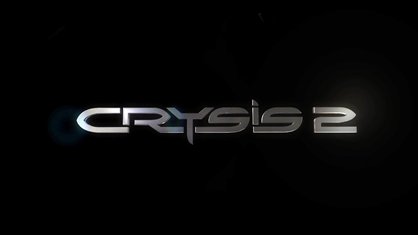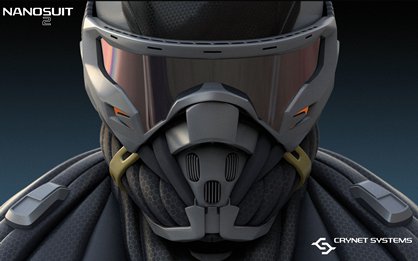Forget Far Cry 2. The real sequel to Crytek’s tropical PC-only shooter was Crysis, a game so powerful it could only run on a nuclear-powered PC the size of a semi truck. Until now.
For the past twelve months, Crytek have, through a series of tech demos, been floating the very real possibility of a Crysis sequel running on consoles as well as PC. CryEngine 3 videos seemed to point towards modifications – but not many. This was the lush jungle and the wide-open sandbox of the original PC game; the eye-searing world that had changed gaming visuals forever in 2004. This was, in fact, proof positive that, with the right amount of time, effort and technical expertise, Crysis could become a console game. And so it has. But not how we thought.
While every one of their previous games has been set in the tropics – a gradual evolution culminating in the beautiful vistas of Crysis Warhead – Crytek’s next game is heading somewhere very, very different. Crysis 2 is swapping the real jungles of the South Pacific for the sprawling urban jungle of… New York. Yep, that’s the same place we’ve been before in Prototype, Alone in the Dark, The Darkness, Ghostbusters, every bloody Spider-man game, and parts of The Godfather 2; a city that has, if we’re honest, become one of the most unoriginal settings in gaming. But for Crysis, and for Crytek in general, it’s virgin territory. And to understand how radical a departure the move is for the series, we need to take a step back.
Set in the near future, Crysis centered on a bunch of high-tech super-soldiers deployed to a Pacific island to rescue scientists from hostile North Korean troops. The first part of the game involved sneaking, running, punching, shooting and swimming around the huge, fictional Lingshan islands, battling human enemies and occasionally sharks. (Seriously, look at the great vids on YouTube). The second part of the game involved, er, aliens. And after extra-terrestrials arrived and blasted the environment with a freeze ray, most people agreed that Crysis – in taking a super-powered leap over the shark – took a turn for the worse.

As Jake ‘Nomad’ Dunn, you were one of only a handful of soldiers blessed with a Nanosuit, a nifty piece of rubberware that offered you four different modes: Strength, Armor, Speed and Cloak. Strength let you jump higher and farther, hurling items with more force; Armor deflected a certain amount of damage; Speed gave you the ability to run and swim faster; while Cloak made you temporarily invisible (obviously). The beauty of the suit was that it let you decide how to approach situations based on your individual needs and abilities.
Standing on an overlook, gazing down at a group of soldiers, do you rush in there with Strength using one human meatbag as a shield, before punching the rest into oblivion – or do you take a more measured approach, utilising the protective power of Armor to pick them off one-by-one? Alternatively, you could sneak in and stealth-kill every last one of the douchebags. It was entirely your choice; and if you wanted to mix-and-match, well, the system actively encouraged that – switching between powers was incredibly simple.
The Nanosuit was half of what made Crysis so appealing, but the tropical setting was the other; it was both an indication of what the PC was capable of and a timely reminder that videogame worlds could be colourful and beautiful, rather than drab and brown. It was a setting unlike the majority of game environments thatseemed happy to settle for cliches such as… New York City. But the main benefit of the tropical setting was its inherent freedom; at least in the early sections, you had a broad, beautiful sandbox to play in.
Sign up to the GamesRadar+ Newsletter
Weekly digests, tales from the communities you love, and more
All of which makes the move to NYC more than a little troubling. The whole game will, apparently, take place there – a place not typically known for its vast tropical environments, or indeed its killer sharks. It’s probably safe to assume we can expect major landmarks like the Statue of Liberty and the Empire State Building to make an appearance, probably in the context of getting blown up. Sadly, Crytek haven’t revealed much – indeed, anything – about the plot yet; if original hero Nomad will return, whether Crysis Warhead’s Psycho will take up the mantle, or if some new guy will step into the Nanosuit.
According to Nathan Camarillo, the Executive Producer at Crytek, it’s for the unique possibilities that come with the new locale. “We decided to pick New York as it’s one of the world’s premier hotspots; it’s a very important place for the entire world. In general, a city offers more opportunities for vertical gameplay than a jungle; the player can jump between different floors, jump on buses, on trucks, in craters, and from one building to another. The player is much more mobile in a city playground, and can change his position more often. They also have a lot more freedom, as they can plan or attack someone from above, and gain an advantage.”

The freeform tactics of the first game are intact, albeit in a slightly different form. Crytek are adapting to the new locale by incorporating all of the vertical elements that come with a major city – in particular, unsurprisingly, the enormous skyscrapers. It makes sense: Crysis puts you in the shoes of an all-but superhero, and what better place for a superhero to fight crime than New York City? It’s been home, variously, to Spider-Man, The Fantastic Four and countless others; spiritually, Crytek are simply trying to draw on New York’s iconic history.



